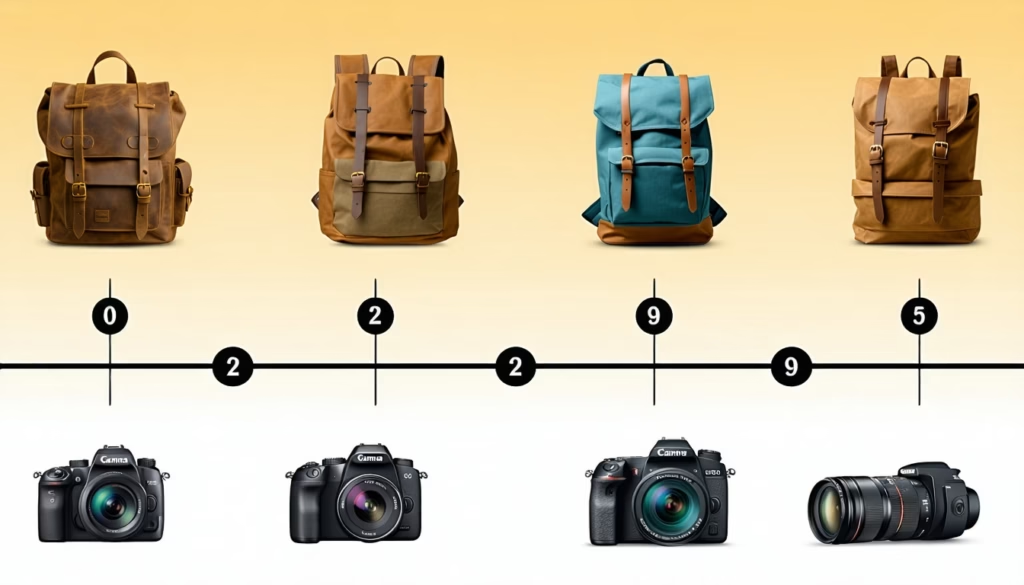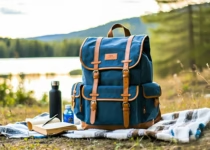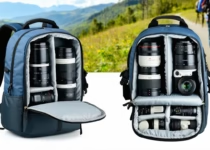The History And Evolution Of Camera Backpacks

Think about slipping on your camera backpack and heading out the door loaded with lenses. It feels modern, right?
But the idea of carrying photography gear on your back goes way back. In this article, we’ll dive into the history and evolution of camera backpacks, tracing how design shifted from bulky leather cases to sleek, weatherproof packs packed with tech. By the end, you’ll know how past breakthroughs shaped the bag you rely on and what to look for when you pick your next pack.
Early Carrying Solutions
In the mid-1800s, photographers hauling large-format cameras needed something more mobile than carts or pack animals. They strapped wooden crates or metal boxes to their backs and braced tripods over one shoulder. It worked, but it was heavy, awkward, and often strained your shoulders and back.
First Photographers’ Kits
Explorers carried bulky cameras, glass plates, and chemicals in custom workshop cases. These kits offered rigid protection but limited your range. You’d scout a location, unload everything, set up, then pack it all again if you wanted a new angle. Speed was never part of the plan.
Leather Cases And Satchels
By the late 1800s, camera makers introduced padded leather satchels. They came with pockets for lens caps and cleaning cloths, and a flap to keep rain off your negatives. Still, these bags hung from one shoulder or your waist, so uneven weight and chafing were common complaints.
- Weight: Early systems could top 50 pounds
- Protection: Glass plates shattered under jostle
- Moisture: Leather and wood warped in the damp
- Accessibility: Retrieving gear meant unpacking the whole case
These hurdles sparked the push toward designs that balanced protection with comfort.
Rise Of Shoulder Bags
Around the 1920s, photographers borrowed from military satchels and mail carriers’ bags. Shoulder packs offered quicker lens swaps and a slimmer profile than wooden cases.
Military Influence
Soldiers used canvas satchels to carry maps, radios, and ammo. Photographers loved the rugged look and added padding for film rolls. Brands like Pacemaker and Graflex adapted these designs, giving pros a reliable field pack.
Drawbacks For Photographers
Shoulder bags solved some access issues but introduced new headaches. The off-center load pulled on one shoulder, leading you to switch sides every few shots. Over a long shoot, that constant swap could distract you from getting the perfect frame. That’s when many pros began to recognize the benefits of using a camera backpack over a shoulder bag.
Invention Of Dedicated Backpacks
In the early 1970s, a collaboration between camera and outdoor gear makers changed everything. Lowepro released the first purpose-built camera backpack in 1975, complete with movable foam dividers and a padded harness.
1970s Breakthrough
Photographers welcomed the idea of custom compartments for bodies, lenses, and flashes. Foam inserts cushion gear from bumps, and adjustable straps let you carry more weight comfortably than ever before. News teams in war zones especially valued the extra mobility.
Material Innovations
Early packs used heavy canvas or untreated nylon. Soon, manufacturers embraced ripstop fabrics, PVC-coated liners, and ballistic nylon. That evolution meant lighter weight, better tear resistance, and basic water protection without clunky rain covers.
Evolution Timeline
Want a quick overview of key milestones? Here’s a snapshot:
| Era | Key Features | Notable Brands |
|---|---|---|
| 1850s–1900s | Wooden crates, leather satchels | Custom workshop cases |
| 1920s–1950s | Canvas shoulder bags | Pacemaker, Graflex |
| 1970s–1980s | Padded foam dividers | Lowepro, Domke |
| 1990s–2000s | Side access doors, ergonomic straps | Kata, Tamrac |
| 2010s–Present | Weatherproof fabrics, modular systems | Peak Design, MindShift |
Modern Technical Backpacks
Fast-forward to today, and camera backpacks have become high-tech workhorses. You’ll find quick-access zippers, laptop sleeves, and water-resistant shells built right in.
Modular Divider Systems
Velcro foam dividers let you carve out spaces for your camera bodies, lenses, and flash units. Move them around to fit a new gear or swap lenses at a moment’s notice. If you want extra tips on layout, check out how to customize a camera backpack with inserts and our roundup of the best camera backpacks with modular dividers.
Weatherproof Fabrics
Ever been caught in a downpour? Modern packs often use coated nylon, welded seams, and water-repellent zippers. Many models include a detachable rain cover for ultimate protection. For more on keeping your gear dry, see weatherproofing tips for your camera backpack or browse the best waterproof camera backpacks for outdoor shoots.
Ergonomic Designs
Long hauls with heavy gear can take a toll on your body. That’s why you’ll find padded shoulder straps, chest clips, and supportive hip belts on most packs. Adjustable back panels help you distribute weight evenly. To keep your spine happy, read how to prevent back pain when carrying camera gear.
Quick Access Doors
Need a lens in a split second? Side and top-loading doors let you grab your camera without taking off the entire pack. Full clamp-style openings provide 180-degree access, perfect for fast-paced shoots.
Common modern features include:
- Multiple access points for bodies and lenses
- Dedicated laptop and tablet sleeves
- Detachable rain covers and water-resistant zippers
- Tripod mounts and water bottle pockets
Specialized Style Variants
Not all shoots demand the same pack. Over time, manufacturers carved out niche designs for specific needs.
Hiking Camera Packs
Trail photographers need hydration bladder pockets, lash points for trekking poles, and gravity-defying comfort. Rugged frames and ventilated back panels help you stay cool on steep climbs. Typical features include:
- External tripod straps and helmet hooks
- Compression straps for load stability
- Padded hip belt with storage pockets
For a deeper look, check the difference between hiking and camera backpacks and learn how to carry a tripod using a camera backpack.
Urban Photography Packs
In city streets, discretion matters. Urban packs blend in with everyday bags, often using muted colors and matte hardware. Anti-theft zippers, hidden pockets, and RFID-blocking compartments keep your kit safe in crowds. Find more in using a camera backpack for street photography and our camera backpack safety tips for crowded places.
Drone And Hybrid Backpacks
Drone pilots needed room for rotors, controllers, and spare batteries—without dumping all their camera gear. Hybrid designs added dedicated bays for quadcopters alongside camera compartments. Typical drone pack features:
- Padded propeller holders and battery sleeves
- Quick-release gimbal pockets
- Controller dock and cable organizers
Explore tips for packing a drone and camera together safely or shop the best camera backpacks for a drone and DSLR combo.
Sustainability And Future Trends
What’s next on the horizon? Expect greener materials and smart tech to take center stage.
Eco-Friendly Materials
Brands are experimenting with recycled PET fabrics, plant-based dyes, and vegan leather. Some packs even use reclaimed climbing rope for lash points. These eco-options cut waste and shrink carbon footprints.
Smart Backpack Features
Imagine a pack that charges your phone or tracks its own location. Integrated power banks, GPS trackers, and RFID-blocking pockets are already showing up. You might even see solar panels woven into backpack exteriors one day, blending convenience with cutting-edge protection.
Frequently Asked Questions
When Did Camera Backpacks First Appear?
The first purpose-built camera backpacks arrived in the mid-1970s, when Lowepro introduced padded foam dividers and adjustable harnesses for photographers.
Why Choose A Camera Backpack Over A Shoulder Bag?
Backpacks distribute weight evenly across both shoulders and hips, reducing fatigue and letting you carry more gear with less strain.
How Do I Customize The Divider Layout?
Most packs use velcro foam dividers that you can resize or reposition. For step-by-step tips, see our guide on how to customize a camera backpack with inserts.
Are Modern Camera Backpacks Waterproof?
Many packs offer water-resistant fabrics and welded seams. Some include detachable rain covers. For full protection strategies, read weatherproofing tips for your camera backpack.
What Features Matter For Hiking With A Camera Pack?
Look for hydration bladder pockets, ventilated back panels, external tripod mounts, and compression straps. See the difference between hiking and camera backpacks for more.
How Should I Care For My Camera Backpack?
Regularly clean the interior and exterior with a soft brush and mild soap. Store it in a cool, dry place. For detailed steps, check how to clean and maintain a camera backpack.
Conclusion
Camera backpacks have come a long way since the days of wooden crates and leather satchels. Today, you get sleek, weatherproof, and ergonomic designs tailored to your shooting style.
Now that you know how design evolved, you can pick a pack that suits your needs. Got a favorite backpack era or tip for fellow shooters? Share it in the comments below.


